That's it! We have carried out Badsender's first carbon audit in collaboration with Sami.eco. By the way, before going into details, a huge thank you to Alexis Lepage for his guidance, patience and pedagogy. It was a first for us, and we learned a lot of new things.
In summary
In 2021, Badsender emitted 42 tons of CO2 equivalent. This represents 60 grams of CO2e per euro of turnover (carbon intensity). Most of our emissions come from our purchases (service providers, data centers), then come the accommodation and catering (mainly meals taken by our employees during their working time). Travel is a minimal source of emissions in our case since all Badsender employees are telecommuting.
In order to improve our carbon footprint in 2022 (20% reduction target of our carbon intensity), we plan to challenge our partners, internalize skills, minimize travel and promote a less meaty diet.
Well, there, that's the summary 😉 Good reading for those who want to discover all the details.
Why a carbon footprint for Badsender?
It's been a long time that the Badsender team is aware of environmental issues. We had organized a workshop at emday in 2019Thomas had written an article on theeco-responsible emailmade a climate mural with all employees in 2021, migrated our "productivity" infrastructure (emails, calendar, websites, file exchange, ...) to Infomaniak, launched the idea of expiration dates in emails... and then actually, it's part of our daily concerns. Not necessarily in relation to our small company's emissions, but in our lifestyles.
Once all this has been said, thedesire to do better (and even to do more) is quickly confronted with the need to objectify the effectiveness of our actions. That's why at the end of last year, Marion D. took matters into her own hands and went in search of support in order to carry out our first carbon assessment.
The carbon footprint is for us a tool for managing our company in the same way as our balance sheet. It will allow us to better understand the reality of the impact of our activityand in so doingguide our decisions in order to improve ourselves.
We are convinced that for moving towards a low-carbon world It is not possible to wait for others to take action. It is everyone's responsibility as an individual, as an economic actor and as a citizen.
It is necessary to to make our society evolve globallyThis means not only an evolution of individual practices, but above all a change in the way the economic world and our public institutions think. Measuring the ecological impact of our structures must become as important as their financial balance.
How does a carbon assessment work?
The parallel between a carbon footprint and a balance sheet is... very immediate... except that for the latter, there are only expenses. So in order to start working on our balance sheet, we gathered a number of data:
- From general information : turnover, number of employees, ...
- The accounting entries The aim is to determine all of the company's expenses, categorize them and deduct the emissions according to different scales.
- On the employees The survey was carried out in order to find out more about our employees and freelancers, who answered (anonymously) a series of questions about their practices. Number (and distance) of business trips, ways of heating their home for telecommuting, type of meals taken for lunch, ...
- The premises In our case, we have answered nothing to everything (see below), but we should have put the number of buildings, the heating mode, the level of insulation, the waste management, ...
- The digital : everything related to our digital environment, servers, sites, platforms used, ...
It took us a good month to gather all the information. In practice, 4 of us worked on the subject (the two Marions, Olivier and me), either in a Rocket room (our internal chat) or during the various progress meetings with Sami.
In terms of workload, even if we haven't timetracked it, it must represent about 30 hours.
Once all this information was collected in a dedicated platform, Sami did the rest of the work.
A standardized methodology
If the first goal of doing a carbon footprint for Badsender is to compare our own practices from one year to another and to judge the relevance of the actions we have implemented, it is also interesting to be able to compare ourselves with others.
The "carbon footprint" method is therefore a standard carried by theCarbon Footprint Association. This ensures a solid methodological foundation that is shared by all our customers. service providers carrying out carbon assessments in France.
Carbon emissions can be divided into 3 "scopes":
- Scope 1: Direct emissions (heating, vehicles, etc.)
- Scope 2: Indirect energy-related emissions (electricity consumption, heat, etc.)
- Scope 3: All other indirect emissions (the majority in fact, but the ones that are least talked about in the public debate)
We leave with a few advantages
Before moving on to the carbon footprint results, it is important to note that Badsender starts with some advantages. We are in full telework since the beginning of Badsender. This means that we have no premises and that there is no commuting for our employees.
Our activity is also 100% dematerialized. We don't produce physical goods, all we need to work is sharp brains, a computer, an internet connection and some digital tools. This is obviously more advantageous in terms of carbon emissions than for other companies since we produce almost no Scope 1 emissions.
Our overall results: 42 t CO2e
After this (very) long introduction. Here is our global result: we issued in 2021 42 tons carbon equivalent.
These 42 tons cover both scopes 1, 2 and 3. On its own, this figure obviously does not mean much. It must be put into perspective. The first reflex is often to compare it to the real world:

We are more advanced?
Carbon intensity, or emissions relative to sales
In order to be able to compare the level of our emissions to other companies, it is usual to report these emissions per euro of turnover (or per dollar). In our case, it is 0.06 kg of CO2e / euro of turnover.
There is a database called CDP (no, not Customer Data Platform?) that allows you to compare yourself by sector.
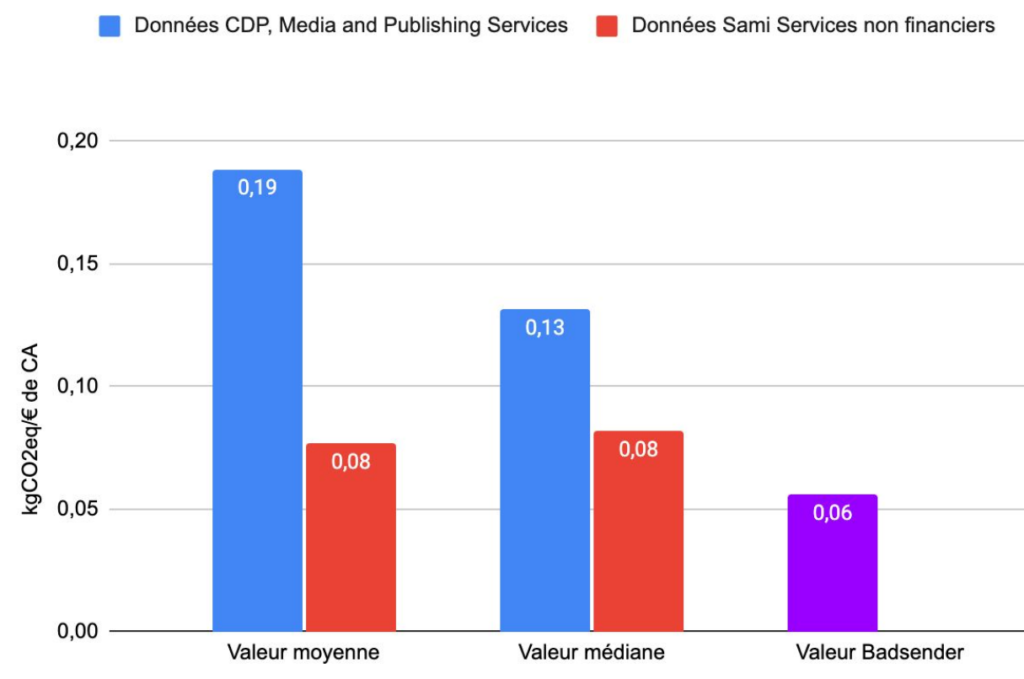
And obviously we are not too bad, even compared to Sami's other clients.
In detail, what weighs most heavily on our balance sheet?
If you break down the 42 tons by station, purchasing and digital purchasing (software, digital services, web hosting, ...) represent more than 70% of our emissions.
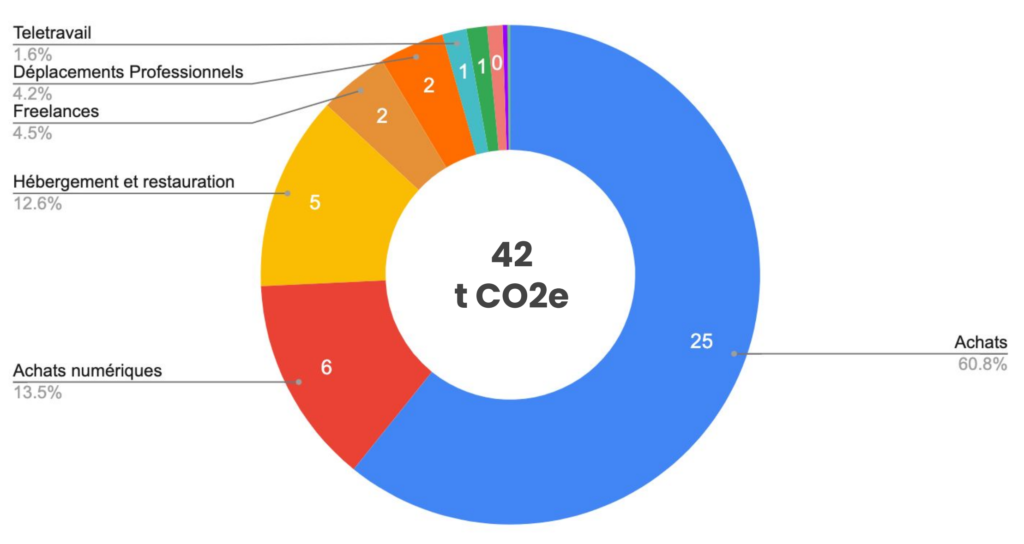
This means that it is largely our purchasing policy that will enable us to reduce our emissions. The emissions generated by the "life" of the employees (accommodation, catering, freelancers, travel, teleworking) represents just 25% of the emissions.
Purchasing
It is therefore interesting to see what is happening in terms of purchasing.
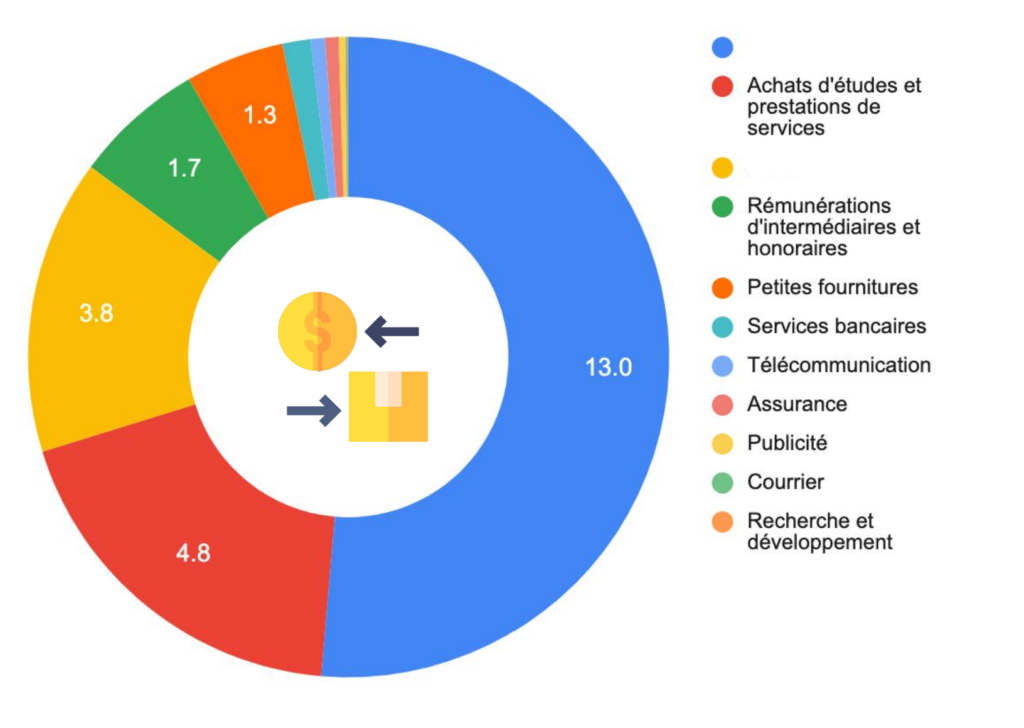
I took the liberty of anonymizing the legend for the blue part and for the yellow part. Indeed, the idea is not to target a particular partner.
Of the 25 t CO2e spent on purchases, the 4 largest categories (in blue, red, yellow and green) are our most important partners (software development, accounting, lawyers, ...) excluding direct employees. These represent 23.3 tons CO2e out of a total of 25. This is a more than half of our global emissions.
It is clearly about our most important room for manoeuvre for this year. It should be noted that the evaluation of carbon emissions of these partners is not based on real data, but on a scale linking expenses (in euros) and average carbon emissions by sector.
So there are several ways toimprove this score next year :
- Ask each of our partners if they have realized themselves their carbon footprint and include "specific emission factors" in our 2022 assessment. This will allow us to see if they are involved in the subject. If they do a carbon footprint, it means that they are invested in a project to reduce their emissions. If they don't realize it, it may be time to change partners.
- Focus on internal skills to the team rather than outsourcing our resources.
Digital purchases
Digital purchases represent 6 t CO2e of the Badsender emissions. Or 14% of the total.
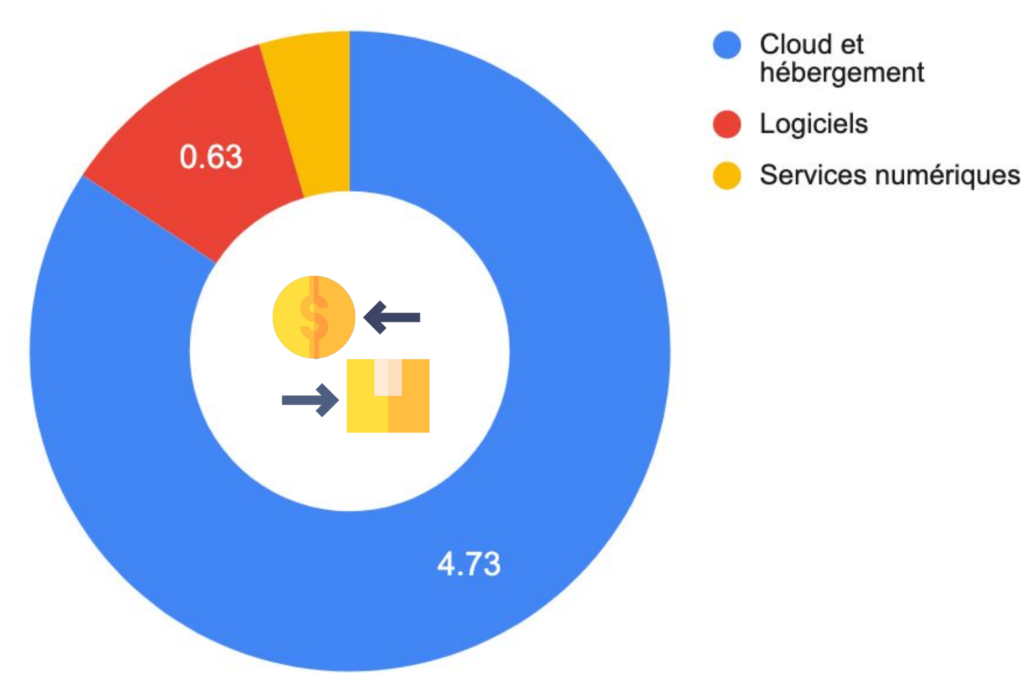
This may not seem like much, but it reflects an ongoing dynamic with the migration of part of our accommodation to Infomaniak in 2021. Migration effort that we intend to continue in 2022.
Travel
I'm not going to comment on all the items (anyway, you have access to our entire anonymized balance sheet in pdf if you continue to scroll down a bit in this article), but I'm still going to focus on Badsender's business travel. When we talk about carbon emissions, this is a point that, along with energy production, monopolizes a large part of the discussions.
In 2021, business travel represents only 4% (2t CO2e) of our balance sheet. Unfortunately, we do not have a comparison with 2019, but we have largely favored missions carried out entirely remotely since the beginning of the COVID crisis. And it shows.
In kilometres travelled, our employees drove 15,000 km during the year. Almost half of them by plane. To tell you the truth, 2 round trips to Sweden represent over 80% of our travel-related emissions. Pure and simple waste. With a few adjustments and some education on the part of the client/collaborator, we could have done this mission remotely.
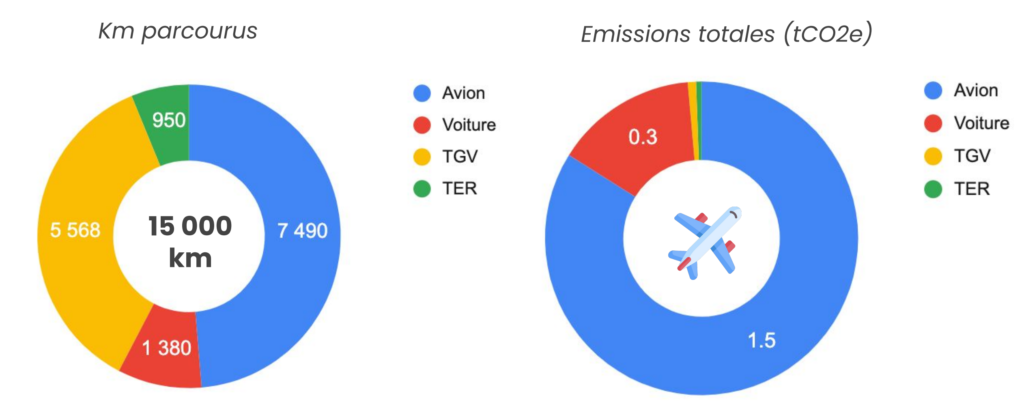
Download our complete carbon footprint!
Well, in reality, it is not 100% complete, I hid some names to make it anonymous to our partners. But in terms of numbers, nothing has been hidden.
Our main orientations to do better in 2022
It's all very well to make assessments and observations, but then we have to take action. The objective is to do better in 2022. Clearly, the main indicator that we will optimize will be thecarbon intensity. The number of kg of CO2e per euro of turnover.
This figure is 60 grams of CO2e per euro in 2021, our goal is to improve this figure by at least 20% by 2022That is to say, to reach 48 grams. A percentage that we will not be able to keep every year for 10 years, but it is the one of the year.
Here is in order of impact, the different orientations that have recently been or are being implemented in our organization in order to achieve this objective :
- Ask for the carbon footprints of all our partners and implement a purchasing and replacement policy for our partners that favors those with a policy of reducing their footprint.
- Favouring the internalization of skills rather than purchasing services from external partners.
- Continue to migrate our hosting infrastructures towards more environmentally friendly solutions. This involves, among other things, a migration of the various technical "stacks" of the Patron (our email editor) towards more efficient data centers, but also by introducingeco-design for future developments.
- Zero travel in plane.
- Minimization of travel at our customers' sites for services of less than a day.
- Promote a less meaty diet with Badsender employees during their working hours.
These six points are those that will have the most significant impact on our carbon footprint. We will add a certain number of points that are already in place, and which, although they will have a less significant impact in the immediate future, seem to us to be decisive in our commitments:
- Present our "carbon ambitions" in our commercial presentations in order to explain some of our approaches (limitation of travel, use of tools different from market standards, ...).
- Systematic purchase of reconditioned equipment (computers, screens, smartphones, ...) and implementation of a Bring You Own Device strategy. Not to mention a lengthening of the renewal cycle (actually we've been doing this forever 😉 ).
- Organize a Digital Fresco with all employees (after last year's Climate Fresco).
- Adding the carbon footprint to our bills (based on the total amount of the invoice).
- Implementing services related toeco-design of email marketing strategies of our customers.
And finally, why not embark on a certification B-Corp. But it will probably be for next year!
Acknowledgements
I would like to thank all the collaborators of BadsenderI would like to thank all of our employees and freelancers for their motivation on the subject. And especially Marion D. who is a bit of a scratch on all environmental issues. But also to our readers and customers who for the overwhelming majority of them are in intense reflection on all these subjects.
It is possible to change things and to become an actor of change. Feel free to contact us or leave a comment if you want to make any remarks (even impertinent ones) or if you have any questions.
See you in a year for the next Badsender carbon footprint and especially to see if we have succeeded in reaching our objectives. If we have the time, we will not hesitate to share with you some of our progress.
See you soon,